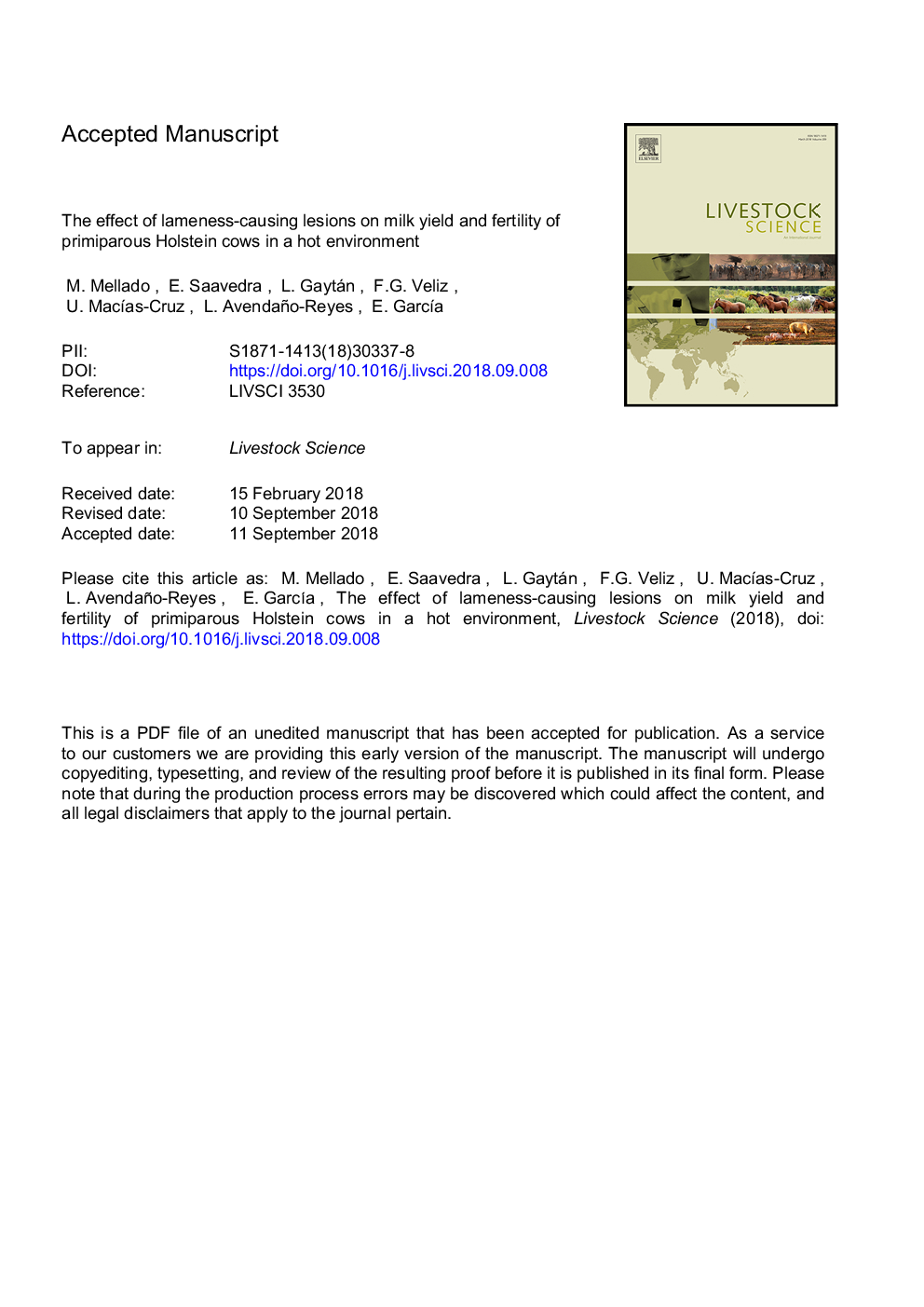| کد مقاله | کد نشریه | سال انتشار | مقاله انگلیسی | نسخه تمام متن |
|---|---|---|---|---|
| 10158125 | 1666506 | 2018 | 32 صفحه PDF | دانلود رایگان |
عنوان انگلیسی مقاله ISI
The effect of lameness-causing lesions on milk yield and fertility of primiparous Holstein cows in a hot environment
ترجمه فارسی عنوان
تاثیر ضایعات ایجاد کننده شل شدن بر تولید شیر و باروری گاوهای اولولینگ در محیط گرم
دانلود مقاله + سفارش ترجمه
دانلود مقاله ISI انگلیسی
رایگان برای ایرانیان
کلمات کلیدی
موضوعات مرتبط
علوم زیستی و بیوفناوری
علوم کشاورزی و بیولوژیک
علوم دامی و جانورشناسی
چکیده انگلیسی
The objective of this observational prospective study was to evaluate the association between lameness (caused by five groups hoof lesions) milk yield and reproductive performance in primiparous lactating Holstein cows housed in open-lot, dirt (dry) floor pens in a hot environment. The effect of age at first calving and season of calving on the occurrence of five hoof lesions was also determined. Data analysis of 2039 cows was conducted, including 385 cows that became lame (cases), and 1697 non-lame cows (controls). The percentage of affected cows by group of lesion was 6.9% for digital dermatitis, 4.0% for abscessed claws, 3.1% for hoof horn diseases (sole hemorrhage, sole ulcer and white line disease), 2.3% for infectious pododermatitis and 1.7 for laminitis. More than one-foot lesion occurred in 28.2% of the lame cows during their first lactation. Cows that calved in spring presented higher incidence (Pâ¯<â¯0.05) of infectious pododermatitis, digital dermatitis, laminitis (coriosis) and hoof horn diseases throughout lactation than cows whose parturition occurred in other seasons. Heifers calving at a younger age (<750 d) presented almost twice the incidence of digital dermatitis than older heifers at first calving. Hoof horn diseases in heifers that became lame within the first 150 days postpartum were associated with 38 d increase (Pâ¯<â¯0.01) in the interval from calving to conception. Lame cows had about 10 percentage points lower all-services conception rate than non-lame cows and cows with infectious pododermatitis and digital dermatitis required an extra service (Pâ¯<â¯0.05) to become pregnant compared to healthy cows. Cows suffering hoof horn diseases within the first 150 days postpartum had a longer (Pâ¯<â¯0.05) calving interval (480â¯Â±â¯104 days) than nonlame cows (425â¯Â±â¯79 days) but similar incidence of fetal losses (fetal death between gestational day 45 and 260; 7.0% versus 5.5%) than controls. Milk yield (305-d) in clinically lame cows (meanâ¯Â±â¯SD, 9738â¯Â±â¯872â¯kg) was significantly less, compared with non-lame cows (10,292â¯Â±â¯1388â¯kg). It was concluded that the milk production potential and reproductive performance of high yielding primiparous Holstein cows in this hot environment is severely lowered if they become lame during lactation. Also, these data show that rates for all hoof lesions were highest in cows calving in spring.
ناشر
Database: Elsevier - ScienceDirect (ساینس دایرکت)
Journal: Livestock Science - Volume 217, November 2018, Pages 8-14
Journal: Livestock Science - Volume 217, November 2018, Pages 8-14
نویسندگان
M. Mellado, E. Saavedra, L. Gaytán, F.G. Veliz, U. MacÃas-Cruz, L. Avendaño-Reyes, E. GarcÃa,
